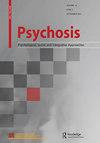Psychotic- like experiences (PLEs) and trauma in adolescents: the role of PLEs' persistence and distress in overall psychological burden
IF 1
4区 医学
Q4 PSYCHIATRY
Psychosis-Psychological Social and Integrative Approaches
Pub Date : 2021-08-06
DOI:10.1080/17522439.2021.1961010
引用次数: 2
Abstract
ABSTRACT Background Psychotic-like experiences (PLEs) have been recognized as having clinical relevance for predicting psychopathological outcomes. Adverse childhood experiences may contribute to the development of these experiences. The objective of this study was to examine the relationship between trauma and PLEs and the role of PLEs’ persistence and accompanying distress in adolescents’ overall psychological burden. Methods 71 adolescents (12–18 years) who were under institutional protection and a community sample of 48 adolescents completed the community assessment of psychic experience (CAPE), the strengths and difficulties questionnaire (SDQ), and the traumatic events questionnaire. Results Previous experience of more traumatic events was significantly associated with greater frequency (r= 0.29, p<0.01) and distress (r= 0.19, p<0.05) in positive dimension and greater frequency in depressive (r= 0.37, p<0.001) and CAPE’s total score (r= 0.31, p<0.01). There were significant positive correlations between CAPE’s total frequency and distress and total SDQ (r= 0.73, p<0.001; r= 0.31, p<0.01 respectively). Discussion Traumatic events are related with more frequent and distressful PLEs. Accompanying distress and PLEs’ persistence were found to have an impact in adolescents’ psychological burden. Mental health professionals should carefully record any history of traumatic events in adolescents’ life, especially to those with frequent and distressing PLEs and vice-versa.青少年类精神病经历与创伤:类精神病经历的持续和困扰在整体心理负担中的作用
摘要背景类精神病经历(PLEs)已被认为与预测精神病理学结果具有临床相关性。不良的童年经历可能有助于这些经历的发展。本研究的目的是检验创伤和PLEs之间的关系,以及PLEs的持续性和伴随的痛苦在青少年整体心理负担中的作用。方法71名受机构保护的青少年(12-18岁)和48名青少年的社区样本完成了心理体验社区评估(CAPE)、优势与困难问卷(SDQ)和创伤事件问卷。结果既往经历的创伤事件越多,正维度的发生率(r=0.29,p<0.01)和痛苦(r=0.19,p<0.05)越高,抑郁(r=0.37,p<0.001)和CAPE总分(r=0.31,p<0.01)的发生率越高(r分别为0.73,p<0.001;r分别为0.31,p<0.01)。讨论创伤事件与更频繁和更痛苦的PLE有关。伴随的痛苦和PLEs的持续存在对青少年的心理负担有影响。心理健康专业人员应仔细记录青少年生活中的任何创伤事件史,尤其是那些经常发生和令人痛苦的PLE的人,反之亦然。
本文章由计算机程序翻译,如有差异,请以英文原文为准。
求助全文
约1分钟内获得全文
求助全文
来源期刊
CiteScore
2.20
自引率
8.30%
发文量
36

 求助内容:
求助内容: 应助结果提醒方式:
应助结果提醒方式:


